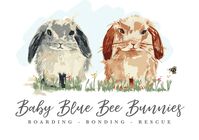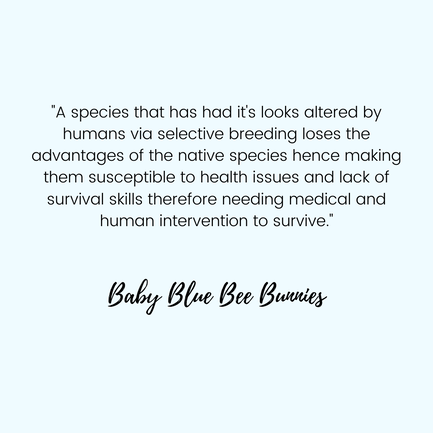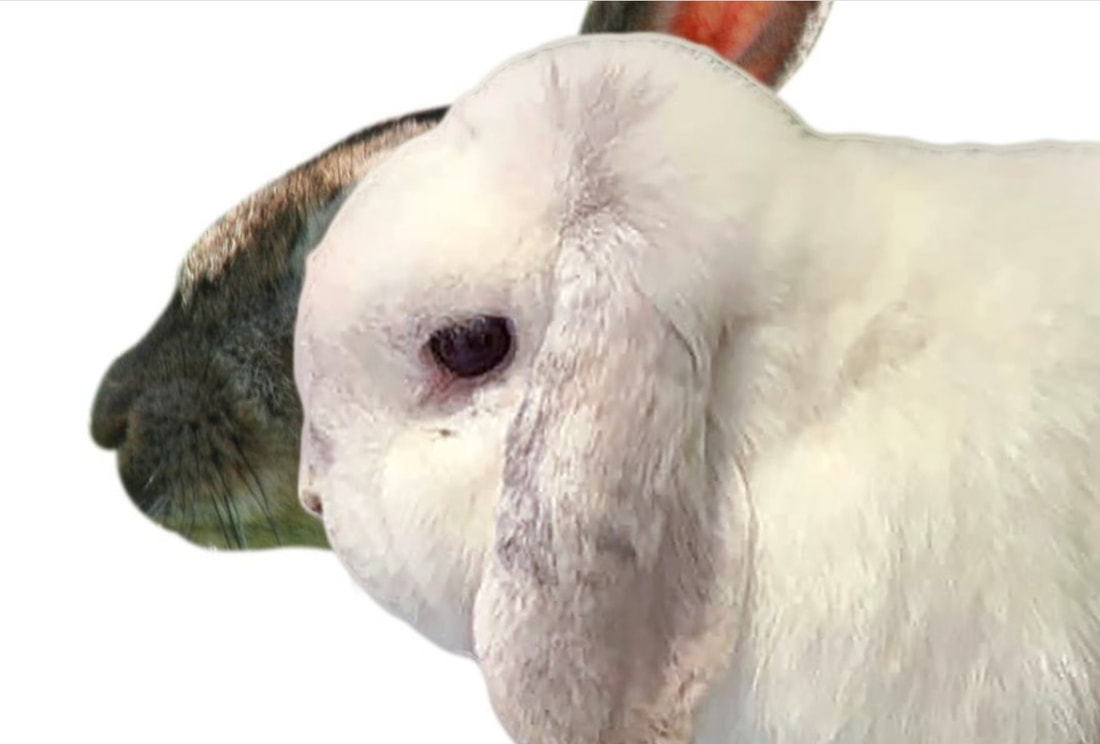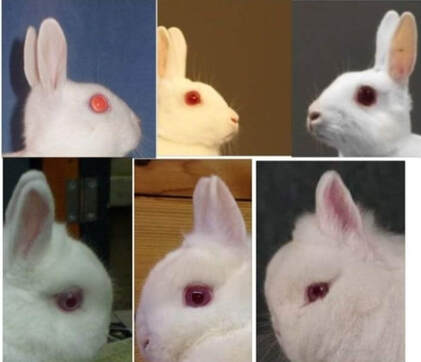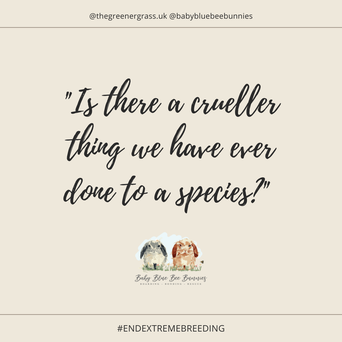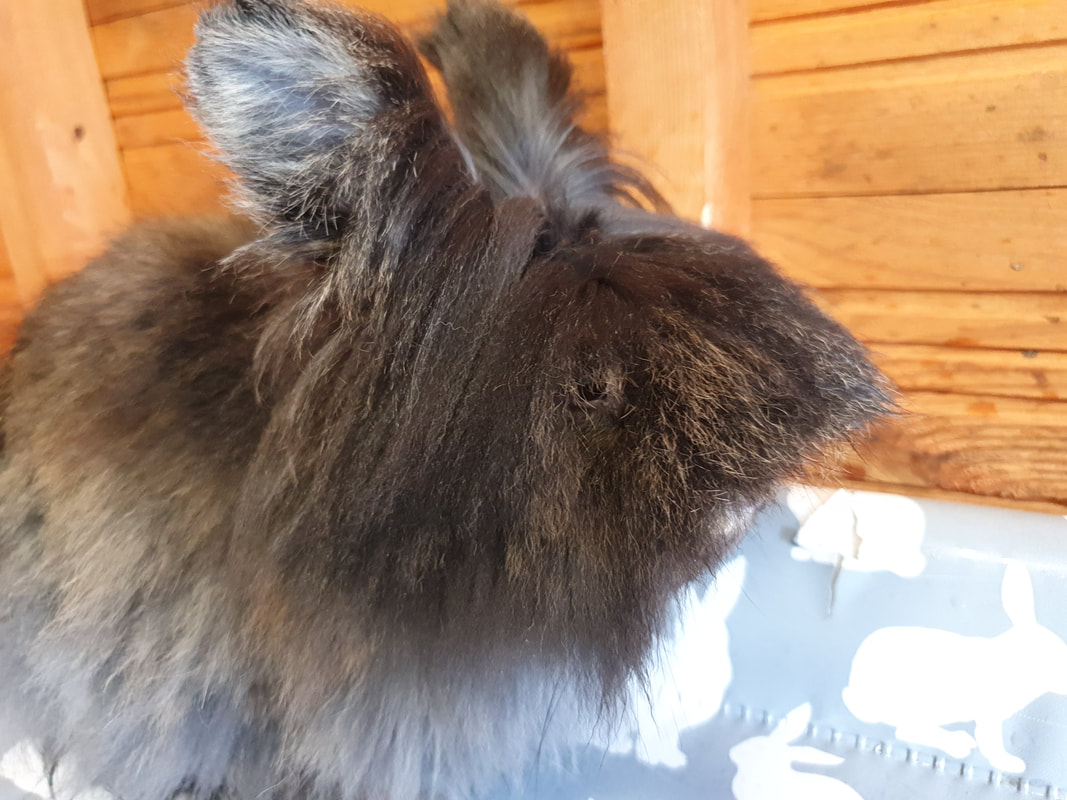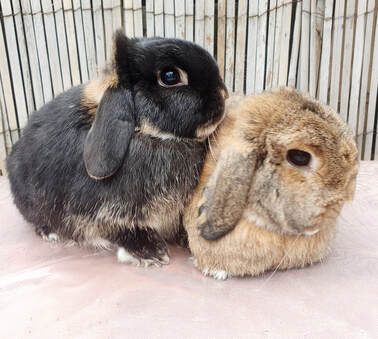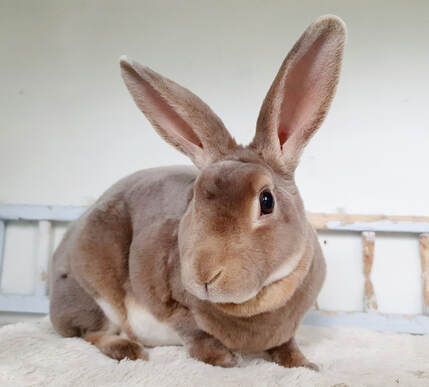End Extreme Breeding
What is the aim of this campaign?
- To raise awareness of genetic related health conditions that are cause by breeding extreme rabbit breeds.
- To encourage people to think before purchasing a "cute teddy lionhead" or "cute squishy lop", understanding the consequences these breeds come with both health and financially.
- To stand with vets and welfare organisations to ban the breeding of extreme breeds (dogs, cats, rabbits, etc).
We have backing for the campaign by Dr Emma Milne, who is the leading vet behind VAB:
Dr Emma Milne: “As a vet who has campaigned for over 20 years on the issues of extreme breeding I am fully behind this campaign. Breeding animals of all species with extreme body shapes and traits is a huge cause of unnecessary suffering. Rabbits with flat faces, lop ears, excessive fur or very little fur and of extreme sizes are all more likely to suffer from health problems than more natural looking rabbits. If you want to buy rabbits rather than adopt I would strongly urge you to choose a breed that is not extreme.” |
Extreme breeds are those who no longer mimic the resemblance of a wild European rabbit. Rabbits have specific features to aid their survival, as a prey species these features are vital for their ability to run, hide and communicate. Selectively breeding "non rabbit" characteristics for domestic pets provides no benefit to the rabbit and takes away these vital abilities. Why is this done? Simply for human aesthetics.
There are four main characteristics that have been altered that class a domestic rabbit as an extreme breed:
- Ear shape (being lop eared)
- Face shape (being Brachycephalic)
- Coat change (having too dense/long/rex type fur or wool)
- Size (dwarves and giants)
How does changing these characteristics affect the rabbits health:
Ears: Hearing and movement of the ears is vital to a rabbits understanding of the world and survival in it. From the moment their ears open, they use them to hear danger and use them to talk to one another. Without this ability, they can become anxious and nervous in their environment as their ability to detect danger is limited. They also struggle in communicating with other rabbits. From the health aspect, lack of ventilation into the ear canal causes wax build up leading to infections and ear abscesses. Lop eared rabbits will inevitably get ear problems in their lifetime and require costly and invasive surgery.
Face: Rabbits being bred for the "cute" factor with squishy, flat faces suffer tremendously. With having big bulgy eyes comes with it Glaucoma risks and with having 28 teeth crammed into a shorter jaw comes with it dental Malocclusion risks. Brachy rabbits are prone to eye, ear and teeth issues and often suffer with respiratory issues. Dental disease is a horrific condition that is common in these breeds and is not resolved by diet, the overcrowding of the teeth can lead to infections, lacerations, abscesses and jaw deformities.
Coat: Domestic rabbits are bred with 4 main coat types. 1 of which is a normal rabbit coat and 3 which are extreme. The effects of changing the coat type of a rabbit for looks and for human desire (and simply put that's what it is - there is no benefit to being fluffy or feeling like velvet!) has a negative effect on the rabbit. Wild rabbits have short slick back coats to wick the water and dirt off away from their skin and it is very low maintenance. Guard hairs protect during rabbit to rabbit interactions against teeth as a form of body armour. Rex rabbits who have been bred to have no guard hairs are prone to skin and muscle tears during bonding as they do not have this protection, not to mention increased sensitivity. Lack of fur also includes protection of their feet which causes Pododermatitis. Long haired, dense coated rabbits and those with wool need constant maintenance or they become matted which can lead to skin infections, heatstroke, dermatitis and in severe cases inability to move their limbs. Their coat is a desirable place to harbour flies and their eggs leading to flystrike and they are prone to GI stasis caused by "wool block" which is excess ingestion of fur which causes a blockage.
Size: Giant rabbits have become increasingly popular pets in recent years. With that giant size however (fully grown adults of over 5kg) comes issues with 3 things: the heart, the hips and the joints. Giants are often seen with protruding third eyelids due to the extreme pressure on their small hearts and they often die young from heart failure. The lifespan of these rabbits is greatly reduced due to mobility issues, increased arthrtis and their hips and back ends struggle with simple movements. Their large size makes them slow to react and run as a small rabbit would and being clumsy often results in hip and leg fractures. Dwarf rabbits that are bred with a round, short, compact body shape suffer in a different way. The long digestive tract of a rabbit is squashed and this causes digestive disorders.
Face: Rabbits being bred for the "cute" factor with squishy, flat faces suffer tremendously. With having big bulgy eyes comes with it Glaucoma risks and with having 28 teeth crammed into a shorter jaw comes with it dental Malocclusion risks. Brachy rabbits are prone to eye, ear and teeth issues and often suffer with respiratory issues. Dental disease is a horrific condition that is common in these breeds and is not resolved by diet, the overcrowding of the teeth can lead to infections, lacerations, abscesses and jaw deformities.
Coat: Domestic rabbits are bred with 4 main coat types. 1 of which is a normal rabbit coat and 3 which are extreme. The effects of changing the coat type of a rabbit for looks and for human desire (and simply put that's what it is - there is no benefit to being fluffy or feeling like velvet!) has a negative effect on the rabbit. Wild rabbits have short slick back coats to wick the water and dirt off away from their skin and it is very low maintenance. Guard hairs protect during rabbit to rabbit interactions against teeth as a form of body armour. Rex rabbits who have been bred to have no guard hairs are prone to skin and muscle tears during bonding as they do not have this protection, not to mention increased sensitivity. Lack of fur also includes protection of their feet which causes Pododermatitis. Long haired, dense coated rabbits and those with wool need constant maintenance or they become matted which can lead to skin infections, heatstroke, dermatitis and in severe cases inability to move their limbs. Their coat is a desirable place to harbour flies and their eggs leading to flystrike and they are prone to GI stasis caused by "wool block" which is excess ingestion of fur which causes a blockage.
Size: Giant rabbits have become increasingly popular pets in recent years. With that giant size however (fully grown adults of over 5kg) comes issues with 3 things: the heart, the hips and the joints. Giants are often seen with protruding third eyelids due to the extreme pressure on their small hearts and they often die young from heart failure. The lifespan of these rabbits is greatly reduced due to mobility issues, increased arthrtis and their hips and back ends struggle with simple movements. Their large size makes them slow to react and run as a small rabbit would and being clumsy often results in hip and leg fractures. Dwarf rabbits that are bred with a round, short, compact body shape suffer in a different way. The long digestive tract of a rabbit is squashed and this causes digestive disorders.
Statistics:
Of the last 50 mini lops that came into our rescue, 38 had dental issues.
Of the last 20 dutch rabbits that came to into our rescue, 0 had dental issues.
It costs our rescue an average of £500 in vet costs to get a mini lop ready for adoption.
It costs our rescue an average of £180 in vet costs to get a dutch rabbit ready for adoption.
Of the last 20 dutch rabbits that came to into our rescue, 0 had dental issues.
It costs our rescue an average of £500 in vet costs to get a mini lop ready for adoption.
It costs our rescue an average of £180 in vet costs to get a dutch rabbit ready for adoption.
Q: Does the way the rabbits are raised affect these health related issues?
A: We know that bad husbandry can affect all breeds and types of rabbits in a negative way (lack of hay and poor diet leading to dental overgrowth, poor living conditions leading to obesity and pododermatitis for example) however the studies show that these extreme breeds face health related conditions regardless of how they are raised or cared for due to the shape of their faces and skeletons. This is due to the *type* of dental related issues that these breeds have (there are 3 main types, one caused by husbandry, one caused by genetics and one caused by breed). Therefore, it doesn't matter how nice an environment they are given, or how well the owner cares for them "by the book", they are still far more likely to develop these issues compared to more wild looking breeds. Not to mention an up eared rabbit will not develop an ear abscess due to lack of ventilation in the ear canal whereas a lop will. No matter where or how you raise them.
Let's take Boop & Brekken as two examples:
Boop was bred by a well known "fancy breeder", sold at 8 weeks old to a family for their child. Given free roam, good diet and raised well for a few months. She was then given up to the rescue at a young age. Good breeder, good husbandry you would argue? Well she arrived needing a dental filing and ear flushing, both due to the shape of her face. She also snores when she sleeps, common with Brachycepheliac breeds and not seen with rabbits with long faces. She cost the rescue £365 to have her treatment to be ready for adoption.
Brekken is estimated 3 years old, she is a Havana type breed. Passed from home to home, kept in poor living conditions and bred by goodness knows who (certainly no one BRC registered). She was rescued and arrived at the rescue in what we expected would be an awful state. Her poops weren't great, but otherwise - healthy! No dental issues, ears spotlessly clear and no snoring. She has cost the rescue £135 to be ready for adoption.
Boop was bred by a well known "fancy breeder", sold at 8 weeks old to a family for their child. Given free roam, good diet and raised well for a few months. She was then given up to the rescue at a young age. Good breeder, good husbandry you would argue? Well she arrived needing a dental filing and ear flushing, both due to the shape of her face. She also snores when she sleeps, common with Brachycepheliac breeds and not seen with rabbits with long faces. She cost the rescue £365 to have her treatment to be ready for adoption.
Brekken is estimated 3 years old, she is a Havana type breed. Passed from home to home, kept in poor living conditions and bred by goodness knows who (certainly no one BRC registered). She was rescued and arrived at the rescue in what we expected would be an awful state. Her poops weren't great, but otherwise - healthy! No dental issues, ears spotlessly clear and no snoring. She has cost the rescue £135 to be ready for adoption.
What about the most detrimental change visually that humans have made to rabbits by selective breeding?
It's got to be the ears!
By breeding rabbits to have lop ears (ears flopping down the side of the face) rather than ones that stand upright like their European ancestors, humans have created a massive problem.
The following statement has since been changed in veterinary textbooks:
".... if lop eared rabbits get ear problems"
to ➡️
".... when lop eared rabbits get ear problems"
A study by the RVC in 2019 shows conclusively that lop eared rabbits are more prone to ear and dental problems. The biggest issue is chronic ear disease and ear abscesses which are inevitable for lop eared rabbits. This issue ONLY occurs with lop eared rabbits. Upright eared rabbits do NOT suffer with this issue. This is due to lack of ventilation and narrowed ear canals, excess wax build up, and ear pain. It is not caused by anything else - breeding or husbandry. The phenotype of lopping ears is what causes the issue. Lop eared rabbit need regular veterinary ear checks to keep on top of these issues and often regular ear flushing.
Ear abscesses / ear disease is one of the most expensive and difficult health issues to treat and requires invasive surgery including ear canal ablation and bulla osteotomy. Belle pictured is one of many lop eared rabbits who suffered due to having lop ears and required this surgery and injectable treatment costing almost £4000. This is the reality of breeding for looks and breeding away from the species original counterparts.
By breeding rabbits to have lop ears (ears flopping down the side of the face) rather than ones that stand upright like their European ancestors, humans have created a massive problem.
The following statement has since been changed in veterinary textbooks:
".... if lop eared rabbits get ear problems"
to ➡️
".... when lop eared rabbits get ear problems"
A study by the RVC in 2019 shows conclusively that lop eared rabbits are more prone to ear and dental problems. The biggest issue is chronic ear disease and ear abscesses which are inevitable for lop eared rabbits. This issue ONLY occurs with lop eared rabbits. Upright eared rabbits do NOT suffer with this issue. This is due to lack of ventilation and narrowed ear canals, excess wax build up, and ear pain. It is not caused by anything else - breeding or husbandry. The phenotype of lopping ears is what causes the issue. Lop eared rabbit need regular veterinary ear checks to keep on top of these issues and often regular ear flushing.
Ear abscesses / ear disease is one of the most expensive and difficult health issues to treat and requires invasive surgery including ear canal ablation and bulla osteotomy. Belle pictured is one of many lop eared rabbits who suffered due to having lop ears and required this surgery and injectable treatment costing almost £4000. This is the reality of breeding for looks and breeding away from the species original counterparts.
How does breeding rabbits with lop ears affect their behaviour?
The ears are the most important sense to a rabbit and it is this sense that teaches them the most about their world. Did you know that the ears of a rabbit open first before their eyes? Around 7 days old they begin to hear the world and learn the sounds of danger. Hearing provides a fundamental protection and safety mechanism, to be able to react fast in the face of danger. Rabbit hear predators coming and can act quickly, bolting underground to escape.
What else do they use their ears for?
Rabbits will communicate with one another using their body language - predominantly their ears. Ears move in various directions depending on what the rabbit wants to say or how they are feeling. When one rabbit approaches another, the way they move their ears indicates to the other rabbit what their intention is. This then allows the other rabbit to react accordingly. Rabbits with lopped ears struggle to communicate with other rabbits as they cannot talk using their ears. This vital piece of communication has been lost, taken out of their control. This leads to miscommunication and a change in communication style.
Hearing is so vital for a rabbit as their most important sense, for example, rabbits will thump loudly to alert their other warren members to danger both above and below the ground, the other rabbits hear this and take cover. This is equally important for domestic rabbits as a way to alert each other. Lop eared rabbits are hearing deficient, being either fully or partially deaf. This makes them unable to hear thumps and vocalisations from each other or danger in their environment. They can get frights easily if they don't see you approaching and can become defensive.
So the most important sense to a rabbit is their hearing? And the most important form of inter species communication is through their ears?
Yet lops struggle to both hear and struggle to communicate with other rabbits. Tell me - Is there a crueller thing we have ever done to a species?
Would we breed dogs without a working nose? Never.
Should we breed rabbits without the use of their ears? No.
How are extreme breeds affected when bonding them to other rabbits?
We often say that breed does not matter when matching rabbits up together, and while that is absolutely correct, breed *does* have an impact on bonding.
Learning and understanding a new rabbit and their communication style is a difficult thing to master as a rabbit. What can make it harder is when being introduced if their ears don't move to tell you whether they are saying hello curiously or want to act defensively. What other way can you communicate then? Using your mouth.
During bonding, domestic rabbits go through a serious of stages to form a relationship together that equates to what they believe to be, a domestic warren. Through this, they must communicate their intentions to the other rabbit, including addressing hierarchal status. Using the mouth is a way to communicate how you feel or what you would like from the other rabbit. Guard hairs protect you as a rabbit from sharp teeth, acting as body armour. This makes nipping feel no more than a nudge and fur pulling like a pinch.
Rexes often struggle during bonding. Why? They have been bred to no longer produce guard hairs that protect them from these nips and fur pulls. They are prone to having skin and muscle tears during bonding and the extra sensitivity can make them on edge.
What else are rexes missing? Whiskers are impeded. Whiskers are important sensory tools to help a rabbit navigate their environment. Also how close another rabbit is to them during bonding! Lack of eyelashes and whiskers can make things more difficult to navigate and can make you hyper sensitive and defensive. This can cause a behavioural issue if multiple tries happens repeatedly.
This is merely a snippet of what struggles a rabbit can face when meeting new rabbits that would not be the case if you were a non extreme rabbit. Struggles that only humans have created.
Additional Resources:
Extreme breeds have lots of additional care needs due to the breed associated health issues that they are prone to. Do you have one of these extreme breeds or are considering adopting one? Read our extreme breeding care guide here.
Visit the Vets Against Brachycephalism website to learn more about the problems of breeding Brachycephalic animals.
